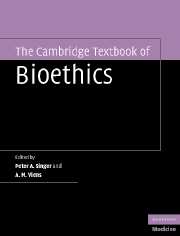Book contents
- Frontmatter
- Contents
- List of contributors
- Acknowledgements
- 1 Introduction
- Section I Information problems
- Section II End of life care
- Section III Pregnant women and children
- Section IV Genetics and biotechnology
- Section V Research ethics
- Section VI Health systems and institutions
- Introduction
- 32 Organizational ethics
- 33 Priority setting
- 34 Disclosure of medical error
- 35 Conflict of interest in education and patient care
- 36 Public health ethics
- 37 Emergency and disaster scenarios
- 38 Rural healthcare ethics
- 39 Community healthcare ethics
- Section VII Using clinical ethics to make an impact in healthcare
- Section VIII Global health ethics
- Section IX Religious and cultural perspectives in bioethics
- Section X Specialty bioethics
- Index
- References
37 - Emergency and disaster scenarios
Published online by Cambridge University Press: 30 October 2009
- Frontmatter
- Contents
- List of contributors
- Acknowledgements
- 1 Introduction
- Section I Information problems
- Section II End of life care
- Section III Pregnant women and children
- Section IV Genetics and biotechnology
- Section V Research ethics
- Section VI Health systems and institutions
- Introduction
- 32 Organizational ethics
- 33 Priority setting
- 34 Disclosure of medical error
- 35 Conflict of interest in education and patient care
- 36 Public health ethics
- 37 Emergency and disaster scenarios
- 38 Rural healthcare ethics
- 39 Community healthcare ethics
- Section VII Using clinical ethics to make an impact in healthcare
- Section VIII Global health ethics
- Section IX Religious and cultural perspectives in bioethics
- Section X Specialty bioethics
- Index
- References
Summary
In October 2001, the USA was on edge following the discovery of several letters containing anthrax. People who worked in facilities that received letters containing anthrax were sometimes stigmatized within their communities. Some employees of American Media Inc., the site of the first anthrax case, were doubly victimized. Physically affected by their potential exposure to anthrax, they were also socially stigmatized by physicians who refused to care for them, schools that turned away their children, and employers of second jobs who refused to let them work: some American Media employees who moonlighted as housekeepers were not allowed into homes to clean (Malecki, 2001).
Suddenly, around 9:50, everything momentarily appears pale pink. There is an enormous bang. Some of my colleagues have looks of terror on their faces. We can see white smoke and debris raining down in the square. The fire alarms are sounding. Although staff members leave, the doctors stay … After several minutes, we gingerly make our way to the front of the building and look down onto the stricken bus. … I grab some surgical gloves and my ambulance service physician identity card … On arrival downstairs, I meet the deputy chairman of the BMA Council … Knowing of my prehospital emergency care experience, he asks me to take over the direction of clinical operations … My assets are a building offering protection from all but a direct hit and 14 doctors, most of them experienced general practitioners with some training in emergency medicine. But we have no equipment, no communications, and no personal protective clothing.[…]
- Type
- Chapter
- Information
- The Cambridge Textbook of Bioethics , pp. 281 - 288Publisher: Cambridge University PressPrint publication year: 2008



